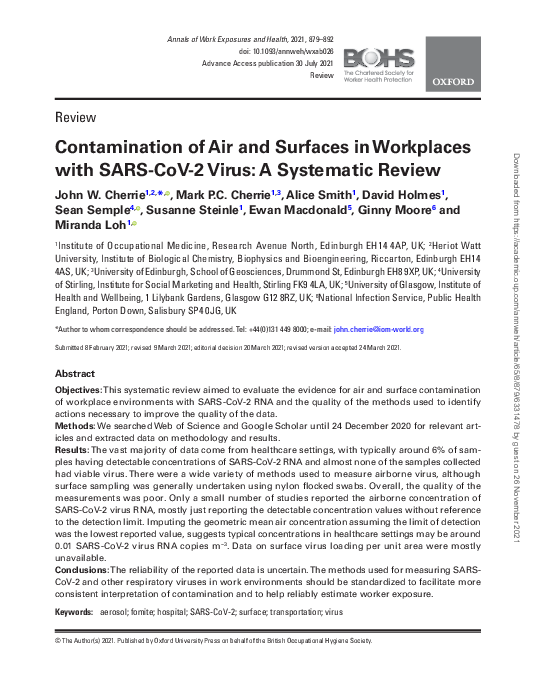Contamination of air and surfaces in workplaces with SARS-CoV-2 virus: a systematic review

Cherrie, John W. ; Cherrie, Mark P.C. ; Smith, Alice ; Holmes, David ; Steinle, Susanne ; Macdonald, Ewan ; Moore, Ginny ; Loh, Miranda
Annals of Work Exposures and Health
2021
65
8
879-892
epidemic disease ; monitoring for air contamination ; working surfaces ; aerosols ; contamination
Risk assessment and risk management
https://doi.org/10.1093/annweh/wxab026
English
Bibliogr.
"Objectives
This systematic review aimed to evaluate the evidence for air and surface contamination of workplace environments with SARS-CoV-2 RNA and the quality of the methods used to identify actions necessary to improve the quality of the data.
Methods
We searched Web of Science and Google Scholar until 24 December 2020 for relevant articles and extracted data on methodology and results.
Results
The vast majority of data come from healthcare settings, with typically around 6% of samples having detectable concentrations of SARS-CoV-2 RNA and almost none of the samples collected had viable virus. There were a wide variety of methods used to measure airborne virus, although surface sampling was generally undertaken using nylon flocked swabs. Overall, the quality of the measurements was poor. Only a small number of studies reported the airborne concentration of SARS-CoV-2 virus RNA, mostly just reporting the detectable concentration values without reference to the detection limit. Imputing the geometric mean air concentration assuming the limit of detection was the lowest reported value, suggests typical concentrations in healthcare settings may be around 0.01 SARS-CoV-2 virus RNA copies m−3. Data on surface virus loading per unit area were mostly unavailable.
Conclusions
The reliability of the reported data is uncertain. The methods used for measuring SARS-CoV-2 and other respiratory viruses in work environments should be standardized to facilitate more consistent interpretation of contamination and to help reliably estimate worker exposure."
Digital
The ETUI is co-funded by the European Union. Views and opinions expressed are however those of the author(s) only and do not necessarily reflect those of the European Union or the ETUI.